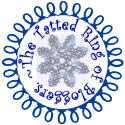Here's that double split chain I was going on about in the last post. This round ends with a ring of 2+2+2, then a chain of 6 ds, a bare thread large enough for 6 more ds, a ring of 2-2+2-2, and another bare thread large enough for 6 ds, then it is joined to the small ring which began this round. (That's the first picture) Then "split chain" stitches are worked back along both bare threads to the point of beginning the next round with a split ring (That's the second picture). Clear as mud, right?
I really should mention that I do the split chain using Marie Smith's method, which can be seen being worked and explained by Frivole here.
Split chains were NOT my favorite activity until I learned to do them this way. It makes so much sense and is easier than the method I used to use (sparingly!)

























